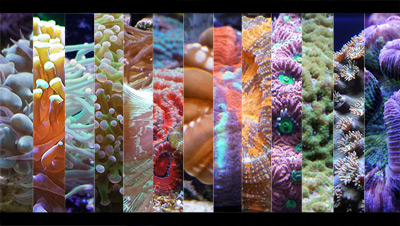Throughout my years as an aquarium enthusiast, I have followed all the advice from all the books I could get my hands on since there were no other hobbyists with the same interest as I in my circle of friends growing up. My aquatic progression took the following path:
- 5-gallon slate & stainless-steel-framed fancy guppy tank from my grandfather
- Goldfish won at the carnival
- Betta bowl
- 10-gallon freshwater tropical tank
- 29-gallon cichlid-specific tanks (bred angelfish and convicts)
- Brackish-water tank
- 55-gallon saltwater FOWLR tank
- Saltwater FOWLR carnivorous tank
- Saltwater soft corals & anemones
- Saltwater large-polyp stony corals (LPS)
- Saltwater small-polyp stony corals (SPS)
The reason I went through all these stages was the lack of technology and information that exist today. I could not keep any corals well at all back in the 1980s because the efficiency of the power protein skimmer did not exist (still used wooden airstones), the lighting was still just T12 fluorescents, and the filtration was not very good at exporting nutrients (canister filters, undergravel filters, wet/dry trickle filters). If you did not do regular water changes, chances are the livestock would all eventually die. The carnivorous fish were the easiest to keep while the omnivores tended to die out due to malnutrition because the foods available at the time didn’t provide adequate nutrition.
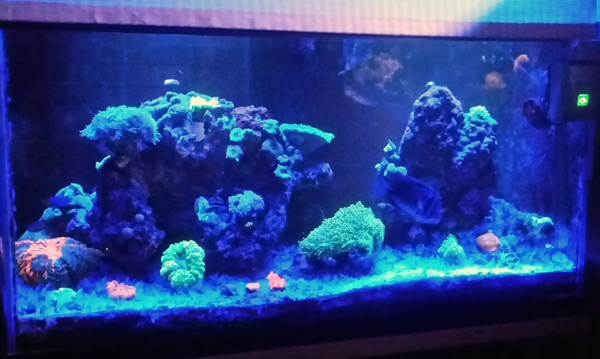
These days, with the help of current technologies, you can more or less jump straight to any stage without the experience of prior stages. Thanks to the vast experiential knowledge base accumulated by hobbyists around the world these last few decades, we now have references and starting points good enough to help just about anyone succeed with the correct coaching. The key is to do your research and consider the source of information from the standpoints of relevance and accuracy. Therefore, in this article, I’m going to jump right to the large-polyp stony corals.
When we think of corals, we typically think of reef-building corals with large, calcium-based skeletons. The LPS corals, on the other hand, tend to have large, flowing, fleshy bodies.
General care parameters
The basic care requirements for some of the easier LPS corals are as follows:
- Temperature: 72-78 F
- Specific gravity: 1.023-1.025
- pH: 8.1-8.4
- Alkalinity: 8-12 dKH
- Calcium: 450 ppm
- Magnesium: 1350 ppm
- Water flow: Low to medium [key parameter]
- Lighting: Moderate [key parameter] (Note: If you’re using LEDs, use diffuse, 120-degree lenses and lower the intensity. T5s are ideal for beginners since they have fewer adjustments that can go wrong.)
The one thing I have noticed with my specimens is that they are more tolerant of—or even like—increased nitrates and phosphates in the water and should be fed to promote optimal health. I keep my LPS in a 90-gallon reef-ready system with a 4-Inch-deep sand bed and just a single powerhead for wave making. However, it plumbs into my main system, totaling 365 gallons. Keeping these corals in a separate tank allows me to cater to their requirements, giving me better control over the water flow and lighting.
Some tips
When purchasing LPS corals, make sure they are fully extended at the store and that their flesh is not receding or damaged on the skeleton or at the edges. Also, ensure that the dealer securely packs large specimens with some extra cushioning material. Otherwise, bacterial infections may arise when their flesh is punctured.
While we’re on the subject of puncturing, I would highly discourage having large hermit crabs and bristleworms in the tank with LPS, since they can easily turn from just being scavengers to doing harm to your corals.
As always, make sure you follow the proper acclimation, quarantining, and dipping procedures on your newly acquired coral. Dip them in Lugol’s iodine or your favorite off-the-shelf product to ensure you are not introducing pests/protozoans into your main system. Some of these corals have their own types of diseases, such as “brown jelly disease,” which can wipe out Euphyllia colonies.
Feeding
Though many of these corals have zooxanthellae (symbiotic photosynthetic algae) in their tissue to make food like plants, species with larger mouths benefit greatly from direct feeding. Small mysid shrimp, very small cut-up pieces of seafood proteins, and even synthetic sinking coral pellets are good options. The key is to tempt the corals to feed by placing a little food on top to encourage their feeding tentacles to come out and then deposit more food onto the tentacles.
Common tools for feeding corals include turkey basters for depositing pellets and small mysid shrimp and tweezers or tongs for dropping meatier foods. You may want to shield your corals with a plastic container to prevent the fish/scavengers in the tank from stealing the food right from their mouths. Feeding shields can be made from 2-liter bottles with the bottom cut out. You simply place the top portion of the bottle over the coral and then inject the food from the top. Or you can use any larger plastic food container and drill holes in it so you can insert food from the top.
Good choices for beginners
Some of the commonly available LPS belong to the following families. This is by no means an exhaustive list, but it includes the species I highly recommend to beginners based on my personal experience.
Family Caryophylliidae
- Bubble coral (Plerogyra sinuosa)
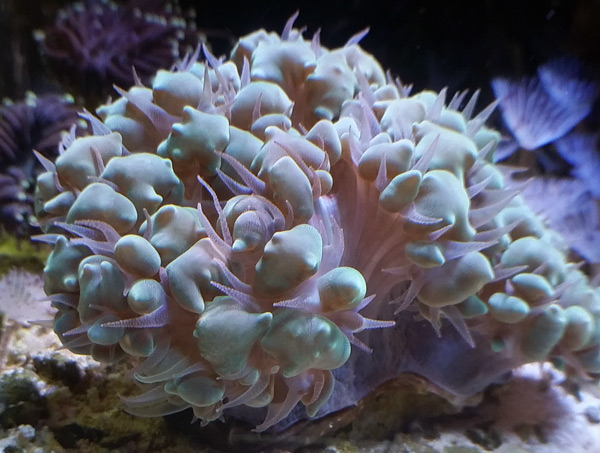
- Hammer coral (Euphyllia ancora)
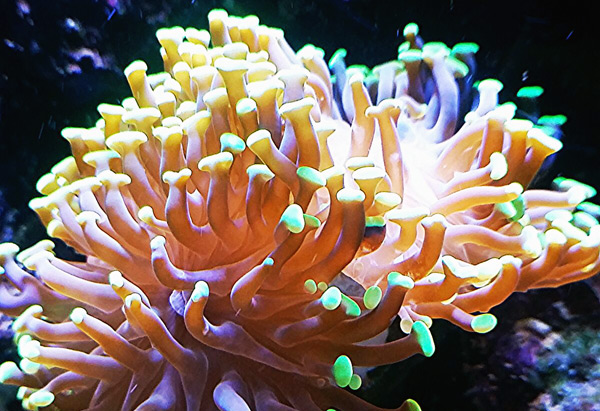
- Torch coral (Euphyllia glabrescens)
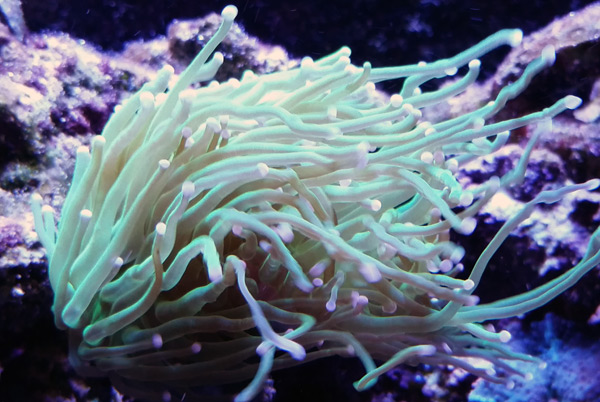
- Frogspawn coral (Euphyllia divisa)
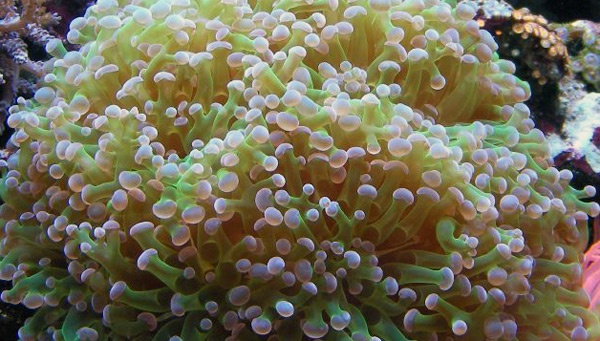
- Elegance coral (Catalaphyllia jardinei) (Note: The ones from Australia seem to be hardier.)
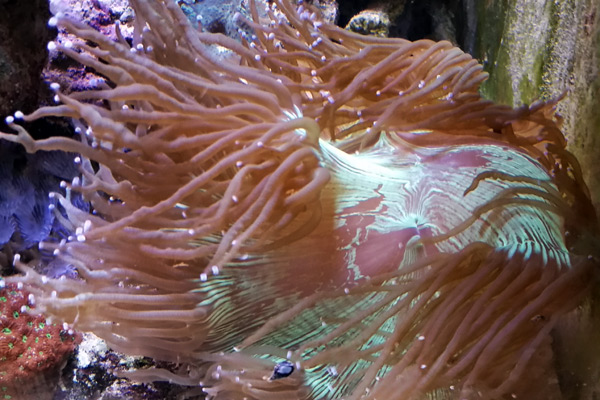
Family Mussidae
- Acanthastrea lordhowensis (Personally, I have had poor luck with these in my system, but they are readily available and have a good low entry price.)
- Button coral (Cynarina lacrymalis)
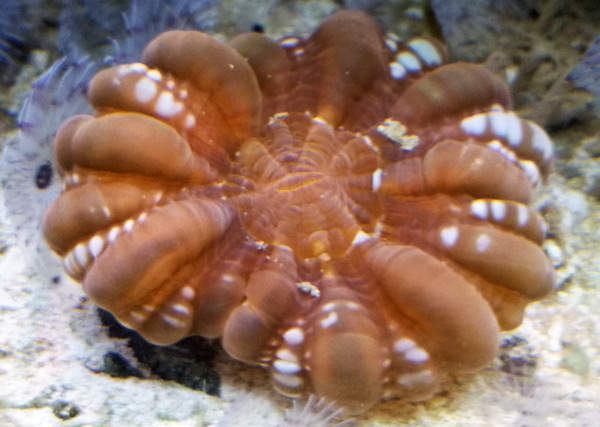
If you can afford one and have the space, the following are as easy to care for as all the above. (Note: the larger the mouths, the more they will benefit from feeding.)
- Donut coral (Acanthophyllia deshayesiana)
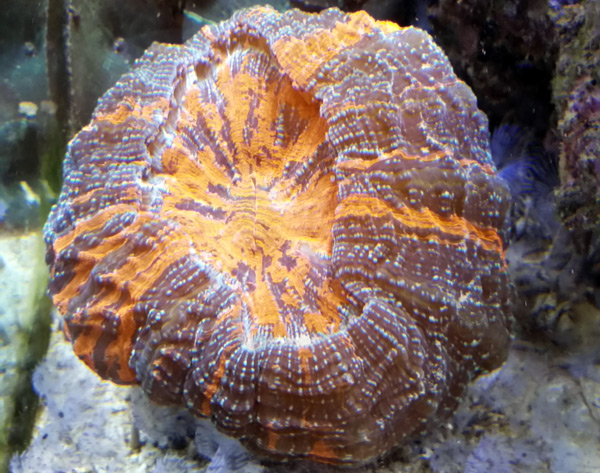
Family Faviidae
- Favites spp.
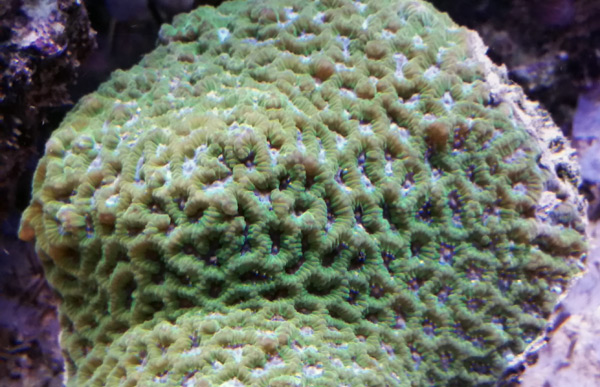
Family Dendrophylliidae
Family Trachyphylliidae
- Open brain coral (Trachyphyllia geoffroyi)


